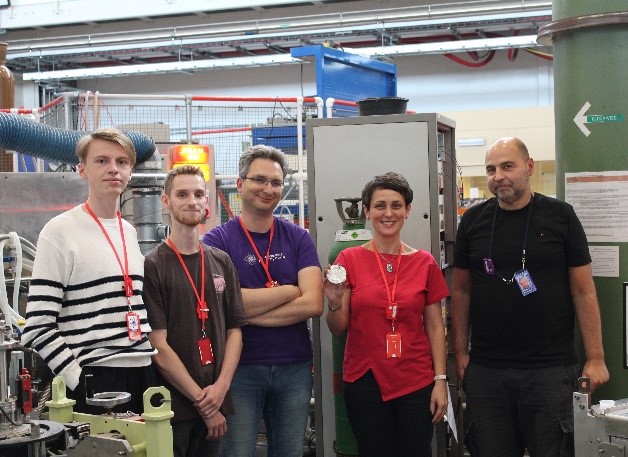 Jagiellonian University is home to two separate research studies which both share a common methodology. Toxic chemical agents or explosives can be detected, and cancerous cells can be treated… both by neutron radiation. Simultaneous use of thermal and epithermal neutrons produced at the ISIS Target Station 1 and employment of a global data acquisition and treatment scheme pioneered at the VESUVIO beamline may provide a novel methodology in both research areas. This, alongside the fact that the VESUVIO beamline scientist Matthew Krzystyniak is a Jagiellonian University alumnus , brought this team to the ISIS neutron and muon source for the first time to take both projects further.
Jagiellonian University is home to two separate research studies which both share a common methodology. Toxic chemical agents or explosives can be detected, and cancerous cells can be treated… both by neutron radiation. Simultaneous use of thermal and epithermal neutrons produced at the ISIS Target Station 1 and employment of a global data acquisition and treatment scheme pioneered at the VESUVIO beamline may provide a novel methodology in both research areas. This, alongside the fact that the VESUVIO beamline scientist Matthew Krzystyniak is a Jagiellonian University alumnus , brought this team to the ISIS neutron and muon source for the first time to take both projects further.
World War Waste
The first of their projects takes us back almost 100 years to World Wars. Ammunition, mustard gas, and explosives were dumped in the Baltic and Mediterranean seas and the English Channel at the end of both conflicts (as well as during the warfare together with sunken ships) to get rid of thousands of tons of leftover dangerous chemicals. This means that firstly, there are many deadly materials on the seabed, but also that these are washing up on coastlines across Europe, where civilians and children can be harmed when finding them. The team’s project is to develop a way to identify these substances when suspicious items are found on coastlines. A portable sensor would allow them to identify the substance as harmful or not. The sensor would produce neutrons which interact with the nearby material in question. This would cause the atoms within it to excite and expel gamma radiation of a certain frequency. The specific frequency (a little bit like a fingerprint) can be detected and allows for the identification of the substance. Uniquely, besides gamma radiation, VESUVIO also detects the neutrons scattered and transmitted by the samples, opening up new avenues for illicit substance detection.
To develop these novel detection schemes, the team needs to characterise samples of the hazardous materials. So, they made their way to ISIS. Their experiment here involved placing surrogate materials mimicking explosives and chemical weapons in the neutron beam and collecting the gamma frequency as well as scattered and transmitted neutrons.
Cancer Therapies
The second area of research this group investigated was cancer therapies- specifically, the technique of Boron Neutron Capture Cancer Therapy (BNCT) that has recently gained renewed interest. The BNCT technique requires boron to be administered to cancer cells of patients. Once the boron is absorbed, the area is exposed to low-energy neutrons which will kill the boron-administrated cells, while leaving the other ones almost free from harm. This method of treatment besides only targeting the infected cells, also has no risk of auto-immune reactions (where the body rejects the treatment as our immune system fights it) which is a risk with many cancer treatments.
A trial of this technique was successfully undertaken in Italy a few years ago1, and it is applied on a routine basis in Japan. The patient had liver cancer and so boron was administered, and surgery was undertaken to remove the liver. It was then taken to a neutron source (nuclear reactor) to irradiate it before being returned to the patient. The entire process took place while the patient was under anaesthesia. The trial was a success with the cancer now eradicated. On their path to improving the treatment the team came to ISIS to test substances to be used in the future in the BNCT. This will help them to calculate safe doses of boron that can safely be administered to patients without any toxic effects.
For the Future
With both projects taking place at the same university these researchers are striving together to get their own smaller-scale neutron source in a lab closer to home. This would allow them to conduct these experiments more routinely. As this project is underway it is important, they have experience with neutron beam techniques so coming to ISIS is an excellent way to “learn from the neutron masters” and collect useful data at the same time.
The team was keen to return to ISIS and perform studies on other high-energy neutron beamlines such as ChipIR and INES. We look forward to their return for future experiments and the publication of their results in future.
1) A Zonta et al 2006 J. Phys.: Conf. Ser. 41 484; DOI 10.1088/1742-6596/41/1/054
